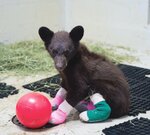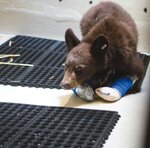“It’s definitely a passion project for all the staff at PAWS. It’s a lot of hard work,” said Laura Follis, Director of Communications and Partnership at PAWS. “Especially when you see these animals in pain, who are suddenly orphaned and in terrible pain and left all alone. They would not survive on their own. We definitely feel a responsibility to step in and basically save their lives.”
One bear came from the Cedar Creek wildfire near Mazama. Two of the cubs, believed to be siblings, were victims of the Twenty-five Mile wildfire fire near Chelan. They were found on August 23 and August 26 respectively from the same location by homeowners Dave and Karen Case. The couple, who live on a 50-acre property amid state and forest land, photographed the wounded bears with their remote wildlife camera. After the Cases called the Washington Department of Fish & Wildlife, workers spent hours scouring the hillside in heat and smoke searching for the lost cubs.
A fourth bear brought to the PAWS facility was so wounded it had to be euthanized.
PAWS began admitting black bears to their facility in 1987 and are the largest bear rehabilitation center in the Evergreen State. Since PAWS treats an averaging six bears cubs per year, having four severely burned bears come in from the wild in such short order is unprecedented.
“What we’re seeing is extremely unusual,” said Jennifer Convy, PAWS senior director for Wildlife. “Historically, burns have not been a common injury we’ve seen but we expect this may become more common and we’re prepared at PAWS to admit black bears and other wild species injured by wildfire.”
The three bears were brought to PAWS with their own paws critically burned. The treatment process is slow and arduous. Veterinarians start by debriding dead tissue on the cubs’ paw pads and clean the underlying tissue to keep it healthy from infections. Workers apply antibiotic cream to the paws to discourage infections and then place silver foam bandages over the severely infected areas. This process is repeated until the staff sees signs of tangible healing.
Once the bears are back on their feet, they’re rehab is hands off. PAWS ensures that human interaction with the animals is kept to an absolute minimum. They place the cubs into an enclosure facility to rehabilitate with other bears. PAWS staff does not talk around the bears and only photographs them with remote cameras while the cubs sleep. The enclosure includes special guillotine doors so staff can clean the enclosure and bring in new food without the bears seeing or hearing them.
“Our goal is to keep wild animals wild,” Follis said. “The bears typically do better when they’re rehabilitated with other bears. They can wrestle with each other, learn from each other, compete for resources with each other.”
Among the food that PAWS feeds the bears is fish, apples, berries, nuts, seeds, insects, and veggies. They provide other food depending on the season and the biological needs of the bears. The staff creatively hides the food in logs, tree branches and other areas so that the cubs must forage for their meals, as they would in the wild.
As the winter months approach, PAWS quiets the cubs’ enclosure to encourage hibernation. They reduce the bears’ food and light to mimic a den. Once the cubs emerge in the spring, the staff will continue to fatten them up for release. When the snow melts and natural food is plentiful, the furry troopers will reenter the wild after a total of 8-9 months of rehabilitation.
While it’s nearly impossible for PAWS workers not to become attached to the bears, the staff makes sure proper boundaries are in place to ensure that the cubs don’t become pets. They refer to the animals based on the geography where they were found.
“We don’t name the bears which is one way of keeping our focus on the fact that these are wild animals,” Follis said. “They don't belong to us.”
Indeed, they belong to wild, and returning there will have its challenges. Nothing is guaranteed. But these lucky cubs, which Follis calls “our own Northwest smoky the bears,” act as the local faces of wildfires, provided that life can arise from the ashes.
PAWS is a private 501(c)(3) non-profit organization that relies on donations from individuals. People who want to help the bear cubs and other injured and orphaned wild animals at PAWS, can donate at paws.org/helpbears.


Comments
No comments on this item Please log in to comment by clicking here